| Article ID | Journal | Published Year | Pages | File Type |
|---|---|---|---|---|
| 5476749 | Energy | 2016 | 8 Pages |
Abstract
Direct injection of fuel into the cylinder of an engine leads to the problem of particulate matter (PM) emissions. Lean-burn gasoline direct-injection (GDI) engines are known to emit higher levels of ultrafine particles than do conventional engines. The level of PM emissions by lean-burn GDI engines is unlikely to meet the EURO-VI emissions standards. In this study, the effects of combustion strategy and excess air ratio on the PM concentrations and particle size distribution were evaluated for a naturally aspirated lean-burn GDI engine. The engine operating conditions-including the fuel-air mixture and load-were varied in order to analyze the PM formation and the particle size distribution. The PM concentration was found to increase dramatically at an excess air ratio of 1.5, at which ratio lean combustion with a stratified mixture occurred. This was regarded as being the transition region between the premixed flames and the stratified mixture flames. Further, an increase in the excess air ratio to beyond 2.0 caused the PM concentration and particle number to increase again, possibly as a result of the relatively high ambient pressure and lower combustion temperature.
Related Topics
Physical Sciences and Engineering
Energy
Energy (General)
Authors
Cheolwoong Park, Sunyoup Lee, Uihyung Yi,
